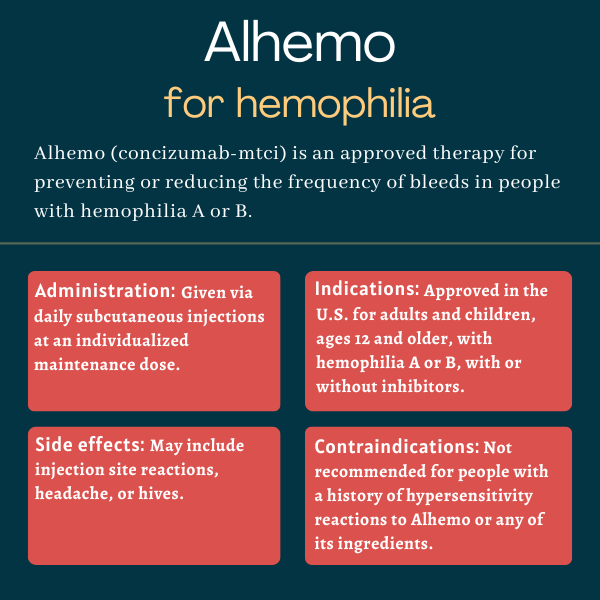Alhemo (concizumab-mtci) for hemophilia
Last updated Aug. 11, 2025, by Lindsey Shapiro, PhD

What is Alhemo for hemophilia?
Alhemo (concizumab-mtci) is an antibody-based therapy that’s approved in the U.S. to prevent or reduce the frequency of bleeds in people with hemophilia A or B, with or without inhibitors.
Excessive or spontaneous bleeding arises in hemophilia due to the lack of certain blood clotting proteins, namely factor VIII (FVIII) in the case of hemophilia A, and factor IX (FIX) in hemophilia B.
Alhemo works by blocking the activity of a protein known as TFPI, fully, tissue factor pathway inhibitor. This protein normally helps regulate blood clotting by slowing the production of a key enzyme, called thrombin, in the clotting process. By allowing more thrombin to be produced, Alhemo aids blood clotting and prevents bleeding.
Because it promotes clotting through a mechanism that doesn’t rely on FVIII or FIX, Alhemo can be used in people who develop inhibitors — neutralizing antibodies targeting the missing clotting factor that can make other standard treatments less effective.
Developed and marketed by Novo Nordisk, Alhemo is administered via daily under-the-skin, or subcutaneous, injections. It can be administered by patients themselves, or by their caregivers, after proper training.
Therapy snapshot
| Brand name: | Alhemo |
| Chemical name: | Concizumab-mtci |
| Usage: | Used to prevent or reduce the frequency of bleeds in hemophilia A or B |
| Administration: | Subcutaneous injection |
Who can take Alhemo?
In the U.S., Alhemo is indicated for routine prophylaxis to prevent or reduce the frequency of bleeding episodes in children and adults, ages 12 and older. Eligible patients will have:
- hemophilia A, with or without FVIII inhibitors
- hemophilia B, with or without FIX inhibitors
Alhemo should not be used by individuals with a history of serious hypersensitivity — severe immune reactions — to the therapy or any of its ingredients.
The medication is also approved for people with hemophilia A and B in several other countries, although specific indications vary.
How is Alhemo administered?
Alhemo is given via daily subcutaneous injections into the abdomen or thigh. It comes in single-use, prefilled injection pens and can be self-administered by patients or given by caregivers after proper training.
Before treatment starts, a healthcare provider will share information on how the medication should be stored, prepared, and administered, and what to do when doses are missed.
For the first four weeks, or about a month, Alhemo is given at a standard recommended starting dose, with a higher loading dose on the first day (1 mg/kg), followed by a lower daily dose (0.2 mg/kg). After that, a healthcare provider will individualize the maintenance dose for each person based on the concentrations of the medication in the person’s bloodstream.

Alhemo in clinical trials
Alhemo’s approval in the U.S. was supported mainly by findings from two similarly designed Phase 3 studies involving people with hemophilia A and B, ages 12 and older. Both studies looked at the amount by which Alhemo reduced the annualized bleed rate (ABR) — the mean number of bleeds per year — for spontaneous and traumatic bleeds requiring treatment relative to on-demand treatment without preventive therapy. The two trials were both dubbed explorer, with different numbers.
- In explorer7 (NCT04083781), Alhemo significantly reduced, by 86%, the estimated mean ABR for treated spontaneous and traumatic bleeds compared with standard on-demand treatments in patients with inhibitors. The median ABR for these types of bleed was zero with Alhemo and 9.8 for people using only on-demand treatment.
- In explorer8 (NCT04082429), treatment with Alhemo similarly reduced the estimated mean ABR for treated spontaneous and traumatic bleeds compared with the no preventive therapy group for people with hemophilia A and B without inhibitors. The mean ABR for these types of bleeds, with Alhemo, dropped by 86% for people with hemophilia A, and by 79% for those with hemophilia B.
Common side effects of Alhemo
The most frequently reported side effects of Alhemo are:
- injection site reactions
- headache
- raised welts or bumps on the skin (hives)
Alhemo also comes with warnings for less common, but potentially serious side effects, including:
- blood clotting events (thromboembolism), particularly in people using high doses of breakthrough bleed treatments or with certain other health conditions
- hypersensitivity reactions, which could include anaphylaxis, a life-threatening allergic reaction
Patients should be closely monitored for these adverse events, and also should be counseled on their signs and symptoms. So appropriate treatment can be administered, individuals taking Alhemo should let a healthcare provider know immediately if they experience these or other unexpected side effects while using the medication. Alhemo may also need to be discontinued in such cases.
Some hemophilia medications may need to be stopped or the dose adjusted before Alhemo is started. Patients should discuss all medications they are using with their healthcare team so as to understand their appropriate use prior to starting Alhemo.
Hemophilia News Today is strictly a news and information website about the disease. It does not provide medical advice, diagnosis or treatment. This content is not intended to be a substitute for professional medical advice, diagnosis, or treatment. Always seek the advice of your physician or other qualified health provider with any questions you may have regarding a medical condition. Never disregard professional medical advice or delay in seeking it because of something you have read on this website.
Recent Posts
- Remember to relax your face, even on difficult days with hemophilia
- Why someone else’s weight struggles are a private matter
- New gene therapy reduces bleeding rates for hemophilia B patients
- Hympavzi boosts quality of life for hemophilia patients in trial
- When women with bleeding disorders show up for each other
Related articles




